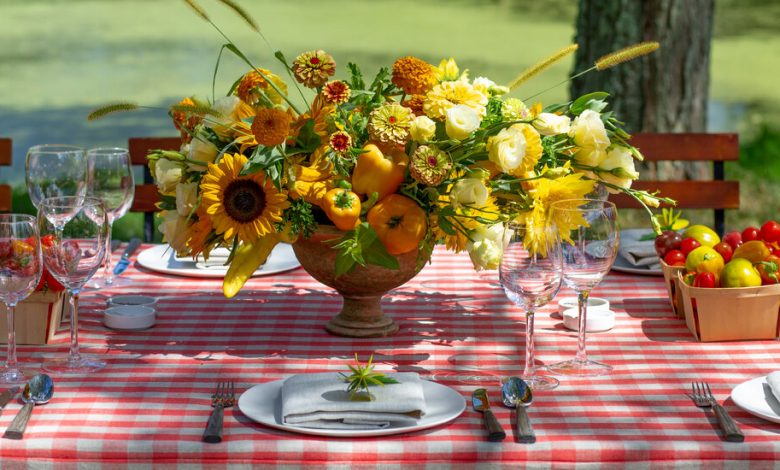How to Host an Outdoor Dinner Party

[ad_1]
As warm weather arrives, so does the opportunity to entertain outdoors — an especially appealing prospect this year, as the pandemic drags on but it feels like we’ve been isolated for long enough.
Whether it’s in the garden, on a deck or on a small balcony, your dinner party should be one that guests remember. That means thinking beyond the basics and creating a dining space that’s as thoughtfully appointed as any indoor dining room.
“When friends come by, you want to make them feel special and welcome,” said Cynthia Zamaria, a home and garden stylist based in Toronto and the author of “House + Flower.” “One of the ways to do that is by creating a beautiful table for them. You can still be working on the potato salad, but the table is set and it’s lovely.”
With Mother Nature on your side, you may even be able to create a space that’s better than any indoor room. “Sometimes, an outdoor room is the most beautiful dining room in the world,” said David Stark, a New York-based event designer.
We asked Ms. Zamaria, Mr. Stark and other designers for advice on how to create an outdoor dining space worthy of the summer ahead.
Choose the Location
If you have a relatively large terrace or yard, lunches and dinners don’t have to be held in the same spot, at the same table you use for everyday meals. Consider moving the table to another appealing location — under the canopy of a tree, near flowers in a garden or beside a pool or water feature.
“Especially after the last two years, people are really looking for an experience,” said Becky Shea, an interior designer based in New York, who designed one dinner party under a willow tree and another partway up a hill at her house in the Catskill Mountains. “Just by changing the setting, people can be immersed in a different environment.”
Michael Devine, a textile designer based in Orange, Va., and the author of “An Invitation to the Garden,” routinely moves his dinner table around the yard. “It depends on what’s in bloom and what looks good — then the table goes there,” he said. “We rotate through the garden all summer.”
It isn’t necessary to have a proper dining table with chairs. You could use lounge furniture if you stick to finger foods, said Chauncey Boothby, an interior designer based in Rowayton, Conn.
Or you could spread out blankets and have a picnic just about anywhere, Mr. Stark said: “It’s the romantic ideal and perfect on a lawn, under a tree or on the beach.”
“The twist is when you don’t use disposable tableware,” he added, “but bring a certain elegance to it” by using proper china and glassware.
Consider a Concept
You don’t need a theme for a dinner party, but it can help — perhaps something as simple as celebrating a favorite color palette, certain types of flowers or vegetables, or a notable date.
“I start by asking what the reason is for the entertaining,” said Kim Seybert, a tableware designer in New York. “Is it the Fourth of July, Labor Day, a birthday party or something else?”
For a Fourth of July celebration, Ms. Seybert said she might use a palette of red, white and blue, but for a birthday party she often aims to reflect the guest of honor’s interests. “One of my friends is very involved with the Museum of Natural History, where they have the butterfly section, so we did a butterfly theme,” she said. For another party, she designed the table around bird-inspired elements.
Mr. Stark has designed outdoor events focused on lawn games like badminton and croquet, as well as parties celebrating in-season vegetables, including a recent one where he set the table to recall a market stand, mixing bell peppers into the floral arrangements and displaying tomatoes in pint-size baskets. “We leaned into the fresh produce of the season, the farmers’ markets and the roadside farm stands,” he said. “There are all kinds of visual delights that come from that.”
Set the Table
Because outdoor dining tends to be more casual than indoor dining, setting the table is a chance to have some fun. Start with a tablecloth, runner or place mats for a fresh, clean surface, and build up from there.
“Having a nice foundation via textiles is essential,” Ms. Shea said. “Belgian linen is a tried-and-true summer fabric, alongside cotton and canvas.”
While she prefers simple tablecloths and napkins in textural solids and stripes, other designers, like Ms. Boothby and Mr. Devine, will use patterned designs for a fanciful touch.
Whatever you choose, it doesn’t have to be expensive. “You can just go to the fabric store and buy yards of beautiful fabric — it could be seersucker, flour sack or linen — and you just cut it and get the beautiful fray on the ends,” said Ms. Zamaria, who has also used inexpensive tea towels bought in bulk as cloth napkins.
For dinnerware, flatware and glassware, you might want to go with matching sets, using pieces with exuberant colors and patterns, or rustic textures. But some of the designers we interviewed also suggested using mismatched items.
“A collected table is a more interesting table,” Ms. Zamaria said. “That’s why I love using mismatched vintage china, my best tarnished silver, etched crystal tumblers and cobbled-together furniture. It looks effortless, yet it’s so elevated.”
Add a Centerpiece
Finish the table with a decorative centerpiece. In summer, it should be easy: flowers, branches and tall grasses clipped from the garden or forest, or bought from a florist or deli, can create tabletop magic.
The natural inclination is to stuff your cuttings into a tall vase positioned at the center of the table, which works well at a round table. But it’s often better to go long and low instead. When you’re setting a rectangular table, try using a series of smaller vases positioned along the length of the table.
“I usually like to do bud vases — smaller ones, all across the table,” Ms. Seybert said, “so it doesn’t obstruct anybody’s view.”
Much like the mismatched dinnerware, the small vases don’t have to be identical. Try mixing varying sizes and heights to create an animated display; if you choose pieces that share a common color or material, they’ll all work together.
If it’s an evening event, candles or portable lanterns should be spread out over the length of the table, as well. Traditional taper candles can look dramatic, but they tend to be tippy and are easily extinguished. If children are involved, or if it’s a windy evening, votive candles might be a better choice, said Ms. Zamaria, who prefers heavy, stemless drinking glasses for the same reason: They tend to stay put.
Include Something Unexpected
A beautiful tablescape will beckon guests to the meal, but what will they find once they sit down?
“I definitely love a conversation starter,” Ms. Seybert said, which usually comes from adding something unexpected or whimsical. She has set tables with carved figurines and napkin rings resembling exotic birds, as well as striped and polka-dot taper candles found on Etsy.
Ms. Zamaria has repurposed garden urns and chillers, and used sections of tree trunks as rustic stools.
Mr. Stark, whose upcoming book with Jane Schulak, “At the Artisan’s Table,” focuses on handcrafted elements for the table, sometimes offers a little trompe l’oeil. He has set tables with paper flower arrangements (in collaboration with the artist Corrie Beth Hogg) and created place cards resembling three-dimensional tomatoes.
But your table setting doesn’t have to be that elaborate: A sculptural vase, purposely imperfect plates and glasses, or a unique pitcher or platter is enough to get most people talking. After all, guests are there to socialize and have fun.
Once your outdoor space is ready, don’t forget one of the most important things: Hosts ought to enjoy themselves, too.
For weekly email updates on residential real estate news, sign up here. Follow us on Twitter: @nytrealestate.
[ad_2]
Source link






